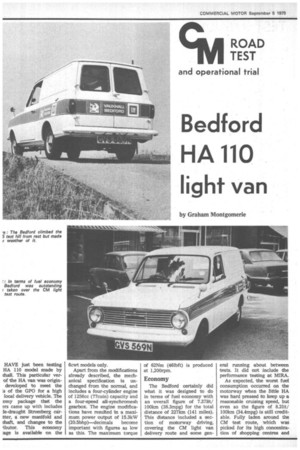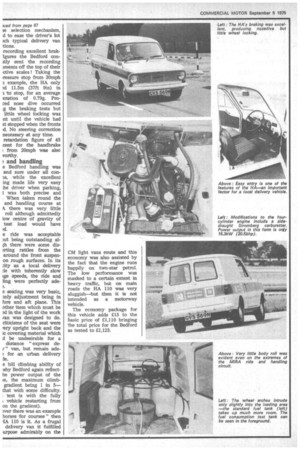Bedford HA 110 light van
Page 68

Page 69

Page 70

If you've noticed an error in this article please click here to report it so we can fix it.
by Graham Montgomerie
HAVE just been testing HA 110 model made by drafi. This particular verof the HA van was origindeveloped to meet the Is of the GPO for a high local delivery vehicle. .The omy package that the ers came up with includes le-draught Stromberg cartiler, a new manifold and shaft, and changes to the ,ibutor. This economy age is available on the 6cwt models only.
Apart from the modifications already described, the mechanical •spedification is unchanged from the normal, and includes a four-cylinder engine of 1256cc (77cuin) capacity and a four-speed ail-synchromesh gearbox. The engine modifications have resulted in a maximum power output of 15.3kW (20.5bhp)—decimals become important with .figures as low as this. The maximum torque of 62Nm (461bft) is produced at 1,200rpm.
Economy
The Bedford certainly did what it was designed to do in terms of fuel economy with an overall figure of 7.37lit/ 100km (38.3mpg) for the total distance of 2271cm (141 miles). This &Stance included a section of motorway driving, covering the CM light van delivery route and some gen eral running about between tests. It did not include the performance testing at MIRA.
As expected, the worst fuel consumption occurred on the motorway when the little HA was hard pressed to keep up a reasonable cruising speed, but even so the figure of 8.21it/ 100km (34.4mpg) is still creditable. Fully laden around the CM test route, which was picked for its high concentration of shopping centres and consequent heavy traffic, the Bedford recorded 7.11it/100km (39.8mpg) which no operator could possibly complain about. This consumption was for an average speed, including stops of 33.1km/h (20.6mph). Under the same traffic conditions but with the van empty, the consumption improved to no less than 6.31it/100km (44.6mpg) for an average speed of 37.0km/h (23.0mph). The full fuel consumption results are shown in the accompanying panel.
Performance
As one would expect, such economy cannot be obtained without a decrease in performance, and this was indeed the case with the HA. I thought the decrease in performance was just about acceptable when viewed against the consumption but it did make the Bedford a very slug gish vehicle to drive, With just over 20 horsepower available, the van made very heavy weather of the motorway section of the test, being barely able to reach 60mph unless on a downhill gradient. With the amount of heavy vehicles about on the motorway, a great deal of anticipation was necessary when overtaking (which could not happen very often !).
In more typical conditions for this category of light -in and out of the shop areas-I was a little surpr to find that this lack of celeration was still very no able. In spite of the stop-t traffic conditions which ust tend to equalise the overroad performance of var vehicles, the Bedford still g out as a slow vehicle.
The excellent gearbox, well spaced ratios and a
se selection mechanism, d to ease the driver's lot ieh typical delivery van tions.
recording excellent brakigures the Bedford conitly sent the recording merits off the top of their 'ctive scales ! Taking the pressure stop from 30mph • example, the HA only ..c1 11.5m (37ft 91n) in • tci stop, for an average eration of 0.79g. Prored nose dive occurred g the braking tests but little wheel locking was nt until the vehicle had st Stopped when the fronts d. No steering correction necessary at any time. retardation figure of 45 cent for the handbrake from 20mph was also vorthy.
and handling
e Bedford handling was and sure under all con • while the excellent ing made life very easy h e driver when parking, t was both precise and When taken round the and handling course at k there was very little roll although admittedly kaw centre of gravity of test load would have d.
e ride was acceptable )ut being outstanding at;h there were some dis:rting rattles from the around the front suspenon rough surfaces. In its :ity as a local delivery le with inherently slow Lge speeds, the ride and ling were perfectly ade).
a seating was very basic, Drily adjustment being in fore and at plane. This other item which must be 'in the light of the work an was designed to do. riticisms of 'the seat were Try upright back and the ic covering material Which d be undesirable for a distance "express de" van, but remain airde. for an urban delivery de.
e hill .cllimbing ability of iaby Bedford again reflecthe power output of the re, the maximum climbgradient being 1 in 5— that with some difficulty. test is with the fully vehicle restarting from on the gradient).
aver there was an example horses for courses" then IA 110 is it. As a frugal delivery van it fulfilled urpose admirably on the CM light vans route and this economy was also assisted by the fact that the engine runs happily on two-star petrol. The low performance was masked to a certain extent in heavy •traffic, but on main roads the HA 110 was very Isluggish—but then is not intended as a motorway vehicle.
The economy package for this vehicle adds £13 to the basic price of £1,110 bringing the total price for the Bedford as tested to £1,123.
























































































































